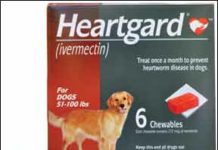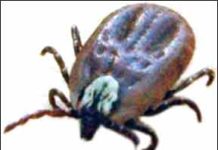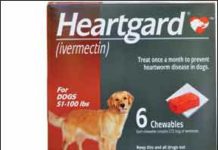Rabies Challenge Fund Studies are in Year Four
Rabies is nearly always fatal to the animals (including humans) who become infected with the disease. That’s why vaccinating our dogs against this deadly virus is required by state law – in order to protect public health, by preventing transmission of this disease from infected wildlife to our pets and to us. Each states requires that dogs and cats be vaccinated for rabies every one, two, or three years.
Heartworm Resistance Update September 2011
In “Time to Step It Up” (WDJ July 2011), we described one small study that showed only Advantage Multi was 100 percent effective against the MP3 strain of resistant heartworms after a single dose. The report was true as far as it went, but new points have emerged that make this a more complex story and one for which we do not have all the answers yet.
Diagnosing and Treatment Options for Symmetrical Lupoid Onychodystrophy or SLO
Dog nails aren’t supposed to fall off, thought first-time dog owner Terrie Huberman some 18 months ago. That’s when she first realized that finding one of her Pug-Poodle mix’s nails on the floor of her Sherman Oaks, California, apartment wasn’t an isolated incident. It all started when, after coming in from a walk, Terrie picked up what would turn out to be the keratin shell from one of Bonzo’s claws. At the time she thought it was something he’d tracked in from outside. Only later did she learn the shell was a telltale sign of Symmetrical Lupoid Onychodystrophy, SLO for short.
Treating Your Dog’s Corns and Warts
Corns and plantar warts may be common on human feet, but they’re rare in dogs – unless the dog is a Greyhound. This breed is prone to corns. Corns are keratin calluses on the front center paw pads, such as under the second toe bone, which lacks subcutaneous tissue or padding. A common treatment for corns is their removal with a small curette or scalpel, followed by smoothing with a pumice stone and the application of salicylic acid pads or ointments. Roberta Mikkelsen of Pearl River, New York, hoped that hulling (surgical removal) would help her Greyhound, Chip, recover from his painful corns. “This is such a common problem in the breed,” she says, “that there is an online forum where people list the things that did or didn’t help. So far there isn’t a cure.” After Chip’s corn was removed, it grew back.
Identifying and Treating Skin Conditions that can Affect Your Dog
Yikes! What happened to Fido’s nose? And what’s wrong with Fluffy’s paw pads? The possibilities are many, and a surprising number of nose and paw pad problems are related. Because illnesses in this category often have similar or identical symptoms, a veterinarian’s diagnosis can be important. The following overview will help you identify, prevent, or treat these disorders. The most frequently asked questions about dogs’ noses concern color. Dogs have black or dark noses and paw pads because of melanin, a pigment that darkens skin. When melanin production slows or stops, the skin lightens uniformly or in patches. The term nasodigital refers to both nose and toes. A thickening of the outer layer of skin (hyperkeratosis) at the edges of the nose or paw pads can develop into painful cracks, fissures, erosions, and ulcers.
Jean Donaldson’s Prep Training for Orthopedic Brace Casting
The following protocol was written with a specific process in mind: preparing a dog to happily hold still long enough to make a cast of the dog’s leg (needed for making a custom-fit mobility brace). But with a little imagination, you can customize Donaldson’s protocol to train your dog to accept any equipment. You will need 1) Glad Press ‘n Seal Wrap; 2) a roll of gauze; 3) a measuring tape; 4) six jars of meat baby food; 5) your dog’s normal ration for one meal (to be hand-fed); 6) six days lead time before your casting day. Plan on spending about 5 minutes per day in place of one of your dog’s meals; don’t cram multiple sessions into one day.
New Lyme Disease Test for Dogs
Researchers at Cornell University's Animal Health Diagnostic Center have developed a new test for Lyme disease in dogs. Available as of June 15, the Lyme multiplex assay is capable of distinguishing between infection and vaccination when vaccination history is available, and between early and chronic disease stages, from a single blood sample. Borrelia burgdorferi, the bacteria that cause Lyme disease, migrate by way of the tissues to the joints, nervous system, and organs, causing fever, pain, lameness, and sometimes kidney failure (Lyme nephropathy). By the time these clinical signs show up, the infection may have been present 6 to 8 weeks or longer.
Orthopedic Equipment for Dogs that Increase Joint Support and Overall Mobility
In our March 2011 issue, we introduced you to a very small sampling of some of the neat “assistive equipment” options that are available to help our canine companions who have limited mobility or other physical issues. We received such a great response that we thought we’d share with you a few more finds that can help make life easier for you and your dog, particularly if he or she is aging or has orthopedic or neurologic issues. Remember: the products mentioned here are only the tip of the iceberg. There are numerous companies making innovative assistive products; what we’re hoping to do here is to get you thinking about some of the possibilities!
Study Reveals Most Common Diseases in Dogs
Banfield Pet Hospital has issued a report analyzing the most common diseases in dogs and cats. The “State of Pet Health 2011 Report” collected data from 2.1 million dogs seen at Banfield’s 770 veterinary hospitals in 2010. Some of the more interesting findings included increases in diabetes, dental disease, ear infections, and flea infestations since 2006. Hookworms and whipworms in dogs also increased during that time period.
Allegations From a Former Merial Insider Regarding Heartgard’s Ineffectiveness
The lawsuit filed by Kari Blaho-Owens, PhD, against Merial, her former employer, contains a number of serious allegations regarding Heartgard’s decreased efficacy and Merial’s knowledge of the problem.We may never know whether all the details alleged in the suit are true. It might take years in court – or it might be settled out of court. But the suit makes for fascinating reading.
Some Heartworm Preventative Medications Have Become Less Effective
As we reported in Whole Dog Journal in March 2011, there is now ample evidence that at least one strain of heartworms has developed resistance to some of the market's best-known preventives. In addition, there is evidence to suggest that one of the most popular heartworm preventives, Heartgard, has an efficacy rate of less than 100 percent. The U.S. Food and Drug Administration's Center for Veterinary Medicine has sent at least one warning letter to Merial, the maker of Heartgard, asking the company to stop claiming 100 percent effectiveness for heartworm prevention. Given these developments, what should responsible dog owners do differently to better protect their dogs? The answer depends a bit on where you live and what you've already been doing to prevent heartworm infection.
ProMeris Discontinued
Pfizer has announced plans to discontinue manufacture and sale of its flea and tick control product, ProMeris. Orders will continue to be filled until September 20, 2011. ProMeris was introduced in the fall of 2007, and touted as the first topical product to use metaflumizone. Pfizer gained control of ProMeris when it acquired Wyeth/Fort Dodge Animal Health in 2009. Pfizer is also the maker of Revolution, used to control fleas and one species of ticks, along with heartworm, ear mites, and sarcoptic mange.

















